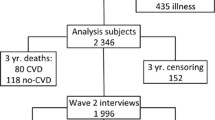Abstract
The Hypertension Detection and Follow-up Program (HDFP) data are reported by diastolic blood pressure (DBP) stratum for four race-sex subgroups. For Stratum I (entry DBP 90–104 mm Hg) in each of the race-sex subgroups (black male, black female, white male, and white female), Stepped Care (SC) participants experienced a reduced mortality as compared to Referred Care (RC). For black males and females in all three entry DBP strata, mortality was lower in the SC than RC. Only in three subgroups did the SC mortality exceed RC: Stratum II (entry DBP 105–114 mm Hg) white females and Stratum III (entry DBP 115+ mm Hg) white males and females. Possible explanations for these deviant findings are discussed. The HDFP was designed to determine the difference in total 5-year mortality between SC and RC; subgroup analyses may be subject to large chance variation and must be interpreted with great caution. The value of vigorous treatment of “mild” hypertension (Stratum I) in males and females, black and white, and the value of treatment for all blood pressure strata in blacks are confirmed by this analysis.
Similar content being viewed by others
References
Hypertension Detection and Follow-up Program Cooperative Group: The Hypertension Detection and Follow-up Program. Prev. Med5207–15, 1976.
Hypertension Detection and Follow-up Program Cooperative Group: The Hypertension Detection and Follow-up Program: A progress report.Cir Res 40(Suppl I):106–109, 1977.
Hypertension Detection and Follow-up Program Cooperative Group: Blood pressure studies in 14 communities: A two-stage screen for hypertension.JAMA 2372385–2391, 1977.
Hypertension Detection and Follow-up Program Cooperative Group: Race, education and prevalence of hypertension.Am J Epidemiol 106 351–361, 1977.
Hypertension Detection and Follow-up Program Cooperative Group: Five-year findings of the Hypertension Detection and Follow-up Program: I. Reduction in mortality of persons with high blood pressure, including mild hypertension.JAMA 2422562–2571, 1979.
Hypertension Detection and Follow-up Program Cooperative Group: Five-year findings of the Hypertension Detection and Follow-up Program: II. Mortality by race-sex and age.JAMA 2422572–2577, 1979.
Alderman, MH: Mild hypertension: New light on an old controversy.Amer J Med 69653–655, 1980 (editorial).
Alderman MH, Madhavan S: Management of the hypertensive patient: A continuing dilemma.Hypertension 3192–197, 1981.
Kaplan NM: Whom to treat: The dilemma of mild hypertension.Amer Heart J 101867–870, 1981.
Lee KL, McNeer JF, Starmer CF, Harris PJ, Rosati RA: Clinical judgment and statistics: Lessons from a simulated randomized trial in coronary artery disease.Circulation 61 508–515, 1980.
Hypertension Detection and Follow-up Program Cooperative Group: The effect of treatment on mortality in “mild” hypertension: Results of the Hypertension Detection and Follow-up Program.N Engl J Med 307976–980, 1982.
Multiple Risk Factor Intervention Trial Research Group: Multiple Risk Factor Intervention Trial: Risk factor changes and mortality results.JAMA 2481465–1477, 1982.
Author information
Authors and Affiliations
Consortia
Additional information
Research upon which this publication is based was performed pursuant to Contract Numbers N01-HV-124 (33-42), N01-HV-229 (31, 37–39, 45), N01-HV-32933, N01-HV-72915, and N01-HV-82915 with the National Heart, Lung, and Blood Institute, National Institutes of Health, Department of Health and Human Services.
Rights and permissions
About this article
Cite this article
Hypertension Detection and Follow-up Program Cooperative Group. Five-year findings of the Hypertension Detection and Follow-up Program. J Community Health 9, 314–327 (1984). https://doi.org/10.1007/BF01338731
Issue Date:
DOI: https://doi.org/10.1007/BF01338731




